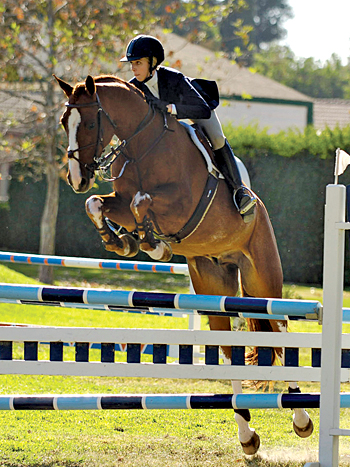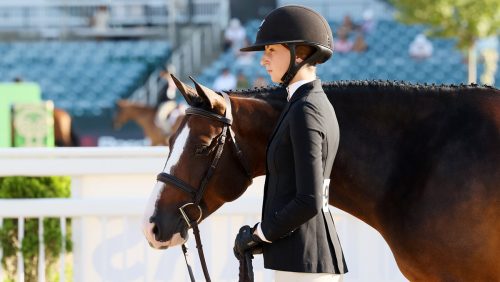Strong flatwork puts Hannah Selleck on her way to winning.
For Hannah Selleck, winning the USEF Platinum Performance Talent Search Finals-West started with a dream and concluded with victory after years of hard work. “You rise to be the best in this class,” said Selleck, 19, and a sophomore in college. “This is a goal I’ve had since I first saw the finals.”
Selleck’s first year in the Talent Search Finals in 2003 did not portend great things when she was unable to complete the gymnastics phase. “I’ve ridden in this class six times, and I’ve been in the top four twice. Winning is a culmination of my dreams,” she said.
 Cynthia Hankins and Scott Hofstetter judged the final, held Sept. 17-21 during the L.A. International Jumping Festival in Burbank, Calif. They started off the four-phase competition with a challenging and interesting flat test for the riders. In groups of six, the 44 riders performed the required flat elements, as well as some additional skills including shoulder-in, haunches-in, half-pass, flying changes of lead and voltes.
Cynthia Hankins and Scott Hofstetter judged the final, held Sept. 17-21 during the L.A. International Jumping Festival in Burbank, Calif. They started off the four-phase competition with a challenging and interesting flat test for the riders. In groups of six, the 44 riders performed the required flat elements, as well as some additional skills including shoulder-in, haunches-in, half-pass, flying changes of lead and voltes.
“We wanted to create a blend of dressage elements, while keeping in mind this is hunt seat riding,” explained Hankins. “We added to the mandatory elements of the flat that are in the qualifying classes. We viewed those as high school and we viewed the finals as college level.”
The judges noted that a number of the riders were unprepared for the “college level” work. While most of the riders executed the various movements with accuracy and demonstrated their understanding of the skills, many riders were weak in the lateral movements, and often horses were bent the wrong way for the various tests. “Many stalled at the high school level,” noted Hankins. “Hannah is very well educated on the flat.”
Some of the riders found the flat phase challenging, but appropriate. “I really liked the structure,” said Selleck. “I felt the flat really prepared us for the gymnastics, especially the small circle exercise.”
Lucy Davis, who finished second overall to Selleck, said, “The flat was intimidating, and they definitely tested us.”
Precision Needed
ADVERTISEMENT
Selleck went into the gymnastics phase in the lead and as a result went last in the order. Hankins and Hofstetter designed a challenging course that demanded analysis and execution. Some riders were bedeviled with basic things like lead changes, supple transitions and riding the hand-gallop in a two-point position. Other riders found the various scope questions throughout the course challenging.
After a cavaletti exercise at the beginning, riders trotted into a grid of a vertical-oxer-oxer. Many rails dropped and a few horses even stopped. Three verticals side-by-side with short, stick standards comprised the next set of tests. Riders had to jump the middle vertical, make a neat left circle and jump the left vertical, followed by a neat right circle and over the right vertical. Misshapen circles and too-large circles plagued a number of riders.
In the middle of the course, riders faced an oxer to a vertical set on 66′ that the judges asked to be ridden in four strides. Riders then had to perform then a reverse half-turn and jump back over the vertical to the oxer in five strides. Less-experienced riders ran at the oxer and ran up the line, frequently pulling a rail at the vertical as their horses jumped flat. Riders also had trouble with the five strides, pulling all the way to the oxer. A five-element grid up the center with a mix of long and short distances proved challenging to do well, and Selleck was the only rider to execute that portion of the test flawlessly.
Riders finished over a bounce exercise, six easy strides to an airy vertical, and then a transition to the walk, a turn on the haunches, and exiting the ring on a long rein. Hearts stopped when Jennifer Stillman, ranked second, jumped awkwardly into the trot grid and her horse, Y2K, stopped at the B element.
The door was open for Selleck to solidify her lead going into the stadium jumping phase, and she took full advantage of the opportunity. As she went around the course, one could hear a pin drop as the audience held its cumulative breath, perched on their seats in the Los Angeles Equestrian Center’s Equidome. Selleck answered every question the judges posed with accuracy, sophistication and style, and they rewarded her with a 97.
Both Adrienne Dixon and Sophie Verges, who are coached by Benson Carroll, had strong performances and were among the top five. Lucy Davis, at 16 one of the younger riders, also emerged among the top tier going into the show jumping phase.
Strong Basics Help
Once again, the judges designed the course in consultation with course designer Scott Starnes. “The five-stride to the four-stride to the bank caused problems for lots of horses,” said Selleck. “I think that there was a lot going on and a lot for the horses to look at on that part of the course.”
Talent Search-West TidbitsADVERTISEMENT• Lauren Hester, 21, topped the USEF Adult Medal Finals. Amateur equitation in California is probably the strongest group in the country, and some of the top amateur equitation riders have teenage children of their own. A student of Karen Healey’s, Hester is the co-captain of the Southern Methodist University (Texas) equestrian team. • Tina DiLandri topped the USEF Zones 8, 9 and 10 Regional Junior Medal Finals. DiLandri and Ali Ohringer posted top scores in the first two rounds and went into the work-off neck-and-neck. Both riders executed strong tests, but DiLandri came out ahead for the win. DiLandri, who finished third in the 2007 USEF/Pessoa Medal Finals (Pa.), is headed east again for the indoor finals. |
Dixon produced the highest score of the stadium phase (95) and secured herself a berth in the final four. Davis also put in a strong ride, and her score of 89 meant that she too would be in the final four. Although Selleck received an 80 for her stadium round for a slight distance problem, her overall score was high enough to keep her comfortably in the final four, and Michelle Morris rounded out the quartet.
When the final four exchanged horses for the final test, Selleck executed accurate rounds on each of the four horses, combined with her lovely style. Selleck’s mother was a professional dancer, and Selleck spent some of her early years studying dance—but horses won out. However, some of the grace and athleticism of dance seems to have carried over to the equestrian world.
Davis was the surprise of the group. The other three riders are in their first or second years of college, and Davis is a high school sophomore. However, she rode accurately and calmly throughout the final-four ride-off, and she finished second behind Selleck. A tough round with Davis’ horse put Dixon in third, and Morris finished fourth after two difficult rounds.
The riders were thrilled with their performances and experiences. “Riding in this class is such an honor,” said Davis. “It’s an honor to do so well in this class, and especially this year we were really tested, and we should be. I am so happy to have gotten in the top four my first year. To finish second is amazing.”
Both Selleck and Davis represented Zone 10 at the North American Junior and Young Riders Championships (Colo.) in August, and each brought home two gold medals. Davis earned team and individual gold at the Junior level, while Selleck collected team and individual gold at the Young Riders level.
“All of the things we did these past three days are things I do with my jumper and that I did to prepare for Young Riders,” said Selleck. “You have to know the basics.”
Selleck’s mount, W.C. Swing, owned by Carol Bird, was named Best Horse by the judges, and the four riders agreed that he was their favorite horse. “He was really adjustable,” said Davis. “He gave me a
really great feeling.”
Both Selleck and Morris ride at Karen Healey Stables; Archie Cox trains Davis, and Dixon works with both Benson Carroll and Buddy Brown.
Marnye Langer














